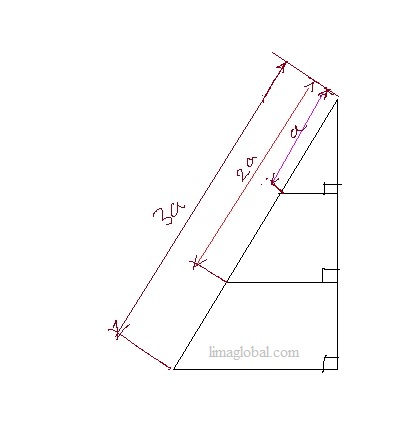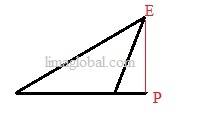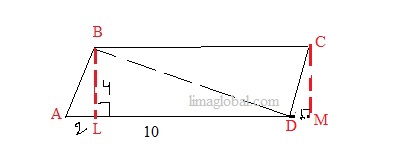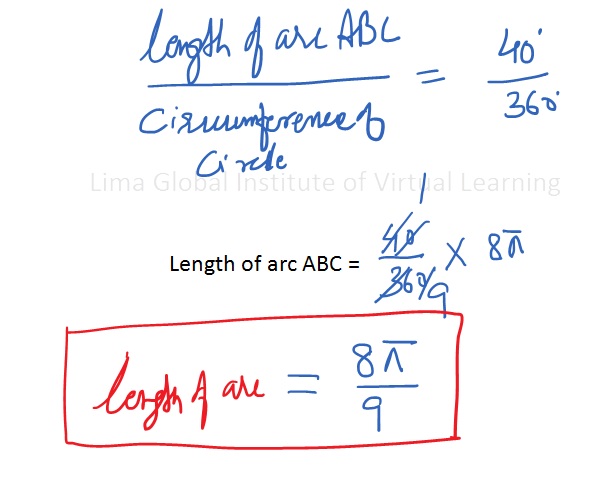Geometry Exercise : Q.1 to Q.8 , Q. 9 to Q. 14
Answer 9
Three triangles are right angled triangles and share common vertex. Hence DCE is similar to DBF, DCE similar to DAG, DBF similar to DAG
It is given that AB = BC = CD
In similar triangles sides of one triangle is in same ratio to the corresponding triangle.
In triangle DCE , If DC = a then
for the triangle DBF; DB = 2a,
and for triangle DAG; DA = 3a
As these three triangles are similar we take that other sides of triangles will also be in same ratio of 1 : 2 : 3
Area of Δ DCE = 42 = ½ x base x height
If we take base of ΔDCE = b and height of Δ DCE = h
Area of ΔDAG = ½ x 3 times of base of Δ DCE x3 times of height of Δ DCE
Area of ΔDAG = 9 x (½ x base of Δ DCE x height of Δ DCE)
= 9 x ( ½ x b x h )
= 9 x 42 = 378
Area of Δ DAG = Area of Δ ADG = 378
Answer 10
AD = AF + FD = 7 + 3 = 10
Area of ABD = ½ x 10 x 5
= 25
(a)
Area of ABCD = 2 times area of ABD
= 2 x 25
Area of ABCD = 50
(b)
Draw a imaginary line EP to take height of triangle AEF
Height of triangle AEF = 5
Area of AEF = ½ x base x height
= ½ x 7 x 5
Area of AEF = 17.5
( c )
As it is given that ABCD is a rectangle that means angle BAD is right angle,
So ABD is right angle triangle, now we can apply Pythagorean Theorem
BD 2 = AB 2 + AD 2
= 5 2 + 102
= 25 + 100
= 125
BD = 5√5
( d )
Perimeter of ABCD = AB + BC + CD + DA
= 5 + 10 + 5 + 10
Perimeter of ABCD = 30
Answer 11.
(a).
Area of ABCD = length x breadth
= 12 x 4
Area of ABCD = 48
(b).
Perimeter of ABCD , We first find length of CD using Pythagorean Theorem
CD 2 = 4 2 + 2 2
= 16 + 4
= 20
CD = √ 4 x 5
CD = 2√5
Perimeter of ABCD = BC + CD + DA + AB
= 12 + 2√5 + 12 + 2√5
Perimeter of ABCD = 24 + 4√5
(c).
To find Length of BD draw an imaginary line from B to AD. BL is perpendicular to AD nad equal to CM = 4
DM = AL = 2 , So, LD = 12 – 2 = 10
Now apply Pythagorean Theorem;
BD 2 = BL 2 + LD 2
= 4 2 + 10 2
= 16 + 100
= 116
BD = √ 4 x 29
BD = 2 √ 29
Answer 12
(a). Circumference of circle = 2πr
= 2 x π x 4
Circumference of circle = 8π
(b). Length of arc ABC
( c )
Answer 13
(a) Circumference of larger circle = 2πr
= 2 x π x 12
Circumference of larger circle = 24 π
(b)
Area of smaller Circle = π r2
= π x 7 2
Area of smaller Circle = 49 π
( c)
Area of shaded region = Area of Bigger circle – Area of smaller Circle
Area of bigger circle = π r2
= π x 122
Area of bigger circle = 144π
Area of shaded region = Area of Bigger circle – Area of smaller Circle
= 144π – 49π
Area of shaded region = 95 π
Answer 14
Surface area of Solid = 2(7 x2 + 10×2 + 10×7)
= 2( 14 + 20 + 70)
= 2( 104)
Surface area of Solid = 208
Length of diagonal AB2 = 7 2 + 2 2 + 102
= 49 + 4 + 100
= 153
Length of diagonal AB = √17 x 9
Length of diagonal AB = 3 √17






